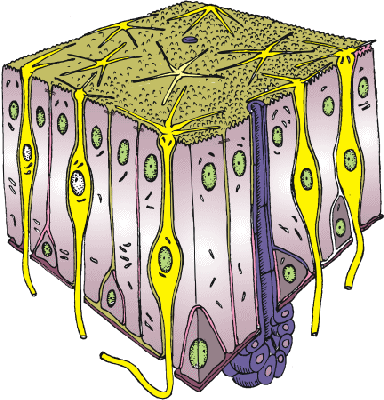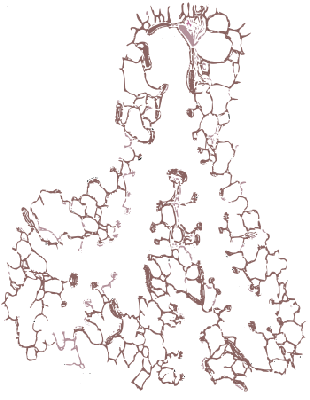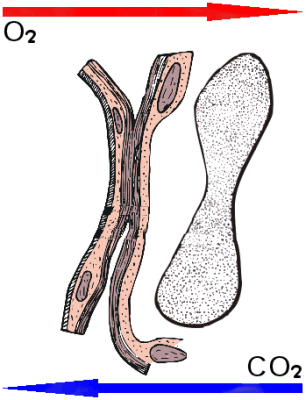IntroductionThe respiratory systemThe respiratory system is divided into a conducting section and a respiratory section. The conducting section consists of the: and is responsible for conducting air to the lungs.The respiratory section consists of the: and is responsible for gaseous exchange |

|
The conducting section
- Nose
- The nasal cavity can be subdivided into:
- The vestibule, and
- The respiratory part
The vestibule is just behind the nostrils, which is formed by the alae. The alae are covered by skin with many sebaceous glands. The respiratory part is lined by respiratory mucosa (pseudostratified columnar epithelium with cilia and goblet cells), which is also found elsewhere in the respiratory system.
Medical fact: The mucosa of the nose has many thin-walled veins. During a viral infection these become dilated, causing a blocked nose.- The olfactory mucosa is found in the superior part of the nasal cavity. It has three types of cells:
- Olfactory cells (modified bipolar neurons)
- Supporting cells
- Basal cells
- Olfactory cells
(modified bipolar neurons) - Supporting cells
- Basal cells

- Pharynx and larynx
The pharynx is lined by respiratory epithelium. Respiratory epithelium is the epithelium lining the respiratory tract. Its purpose is to moisten, protect the airways and form a barrier to potential pathogens and foreign particles, preventing infection and tissue injury.
The larynx is a tube which is kept open by cartilage. It is covered by unkeratinized squamous epithelium in areas of high friction. In areas with low levels of friction, it is covered by respiratory epithelium. The epiglottis forms part of the larynx, and is a leaf-like structure with hyaline cartilage in it centre.
Medical fact: Cigarette smoking causes irritation to the mucosa of the larynx, resulting in changes of the epithelium. The respiratory epithelium will change into squamous epithelium, and if the irritation continues this will change into squamous cell carcinoma. - Trachea
The trachea is a tube which is kept open by 20 C-shaped cartilaginous rings. The gap at the back, at the openings of the cartilage rings, is filled by the paries membranaceous. Neighbouring rings are joined by connective tissue, which is continuous with the perichondrium.
- The trachea has the following layers:
- Mucosa, consisiting of respiratory epithelium and a thick lamina propria
- Submucosa, containing mixed glands and lymph follicles
- Cartilage, consisting of C-shaped hyaline cartilage
- Adventitia, consisting of connective tissue
Medical fact: The cilia are paralysed by cigarette smoking and viral infections, causing the accumulation of mucus. - Bronchi
Some bronchi are extrapulmonary (outside the lungs), while others are intrapulmonary. The extrapulmonary bronchi are histologically similar to the trachea.
- The intrapulmonary bronchi have the following layers:
- Mucosa, consisting of respiratory epithelium and a lamina propria
- Smooth muscle, which are arranged in a spiral fashion
- Cartilage, which are irregularly shaped in plates
Medical fact: The whole respiratory system is very exposed to infection. The bronchi have abundant lymphoid tissues in the form of nodules containing B- and T- lymphocytes. These interact with the lung macrophages. This is called BALT (bronchus-associated lymphoid tissue). - Bronchioles
The bronchioli that penetrates a lung lobule is called a preterminal bronchioli. They branch to form terminal bronchioles.
- The bronchioli have the following layers:
- Mucosa, consisting of simple columnar epithelium, thin lamina propria and Clara cells
- Smooth muscle, arranged in spiral fashion
Medical fact: Contraction of bronchiolar smooth muscle is an important factor in asthma, causing increased airway resistance. In small babies the smooth muscle is not well developed, therefore medications acting on the smooth muscle is not effective in treating babies with bronchiolitis.The differences and similarities between the trachea, bronchus and bronchiole can be summarized as follows:Histological component Trachea Bronchus Bronchiole Epithelium Respiratory Respiratory Columnar Elastic tissue Present as lamina elastica Longitudinal bands Fibres only Cartilage C-shaped Plates None Glands Goblet and in submucosa Goblet and between muscle and cartilage None Clara cells Absent Absent Present Medical fact: Elastic tissues play a very important role in the conducting system of the lungs. With inspiration the diaphragm moves downwards, causing the tubes to elongate. The elastic components enable the tubes to elongate, and move back to their original position with expiration.
The respiratory section
- Respiratory bronchioles
The respiratory bronchioles open into alveolar ducts, which open into alveolar sacs. These should rather be seen as open spaces than tubes.
The walls of the respiratory bronchioles are the same as other small bronchioles, except that here and there it has an alveolus in its walls. Gaseous exchange can thus takes place.
- Alveolar ducts, alveolar sacs and alveoli
Larger spaces (alveolar ducts) open into smaller spaces (sacs and alveoli). These spaces are formed by interalveolar walls. These interalveolar septae comprise of blood vessels, elastic fibres and reticular fibres, lined by epitehelial and other cells. Air in the alveolus, is thus separated from the bloodstream by the following layers:
The interalveolar septae are thus very thin.The epithelium that lines the alveoli forms a continuous membrane.
- Three types of cells are distinguished in this epithelium:
- Simple squamous alveolar epithelial cells (pneumocyte type 1)
- Secretory cells (pneumocyte type II)
- Alveolar macrophages (dust cells)
Medical fact: The pneumocytes type II produce surfactant. A deficiency of surfactant causes respiratory distress syndrome in newborns, and is associated with prematurity. It is the leading cause of death in premature babies. In the normal newborn, the onset of breathing is associated with a massive release of stored surfactant, which lowers the surface tension in the alveoli. Surfactant also has a bactericidal effect.The alveolar walls are not thin in all places. Some thicker-walled areas exist, which acts as a safety mechanism. A small amount of fluid can be contained in this area without causing problems with breathing (e.g., in cases of heart failure). There are no lymph vessels in the interalveolar septae.
Contact exists between different alveoli. These can exist either as alveolar pores between adjacent pores, or as short canals where the terminal bronchioles open directly into the adjacent alveolar sacs (Lambert sinuses).
Medical fact: Alveolar pores and Lambert sinuses are very important safety mechanisms in the lungs. If a specific area in the lung is obstructed (e.g., carcinoma in a bronchus), air can still reach the affected area through these short circuits. It also helps to equalize the pressure in various areas of the lungs.
General histology of the lungs
Lung lobules are pyramid shaped, with an apex (towards the hilum) and a basis (towards the surface of the lungs).
The branches of the pulmonary artery follows the branching of the bronchi and bronchioles. In the interalveolar septae these blood vessels become capillaries that merge to form interlobular veins.
The pleura covers the lungs. It has two layers, parietal and visceral. Both membranes are composed of mesothelial cells resting on a fine connective tissue layer with collagen and elastic fibres. These two layers define a cavity lined entirely with mesothelial cells which is filled with a thin layer of fluid.
© februarie 2005 marius loots



